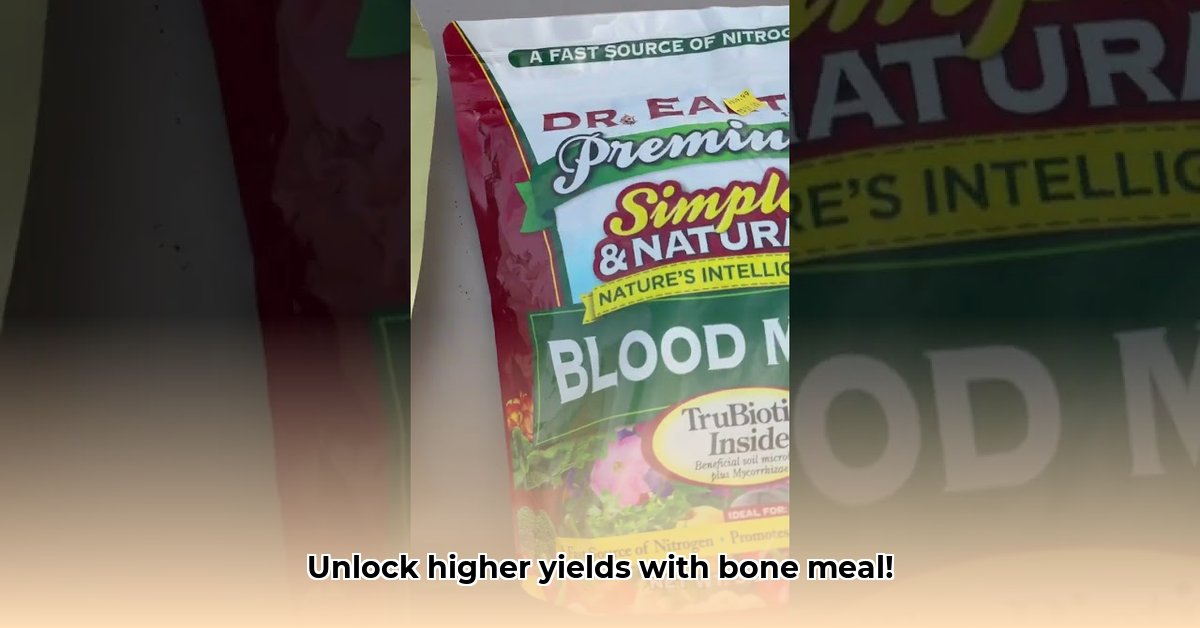
Understanding Bone Meal: A Natural Soil Amendment
Bone meal, readily available at Tractor Supply and other retailers, is a natural, slow-release fertilizer derived from processed animal bones. It's a rich source of phosphorus (P), essential for robust root development and vibrant flowering, and also provides calcium (Ca), strengthening plant cell walls. This makes it a valuable asset for sustainable farming practices. Think of it as a time-release capsule of essential nutrients for your plants, gradually feeding your crops over time. For more information on retailers like Tractor Supply, check out this helpful resource.
Soil Testing: The Foundation for Success
Before applying any fertilizer, including bone meal, conduct a soil test. This crucial step reveals your soil's nutrient levels, including phosphorus, and its pH. Knowing your soil's phosphorus content (measured in parts per million, or ppm) is critical. Why waste resources on bone meal if your soil already has ample phosphorus? A soil test guides you toward efficient fertilizer application, maximizing your investment and minimizing environmental impact. You can easily obtain soil testing kits from Tractor Supply or your local agricultural extension office.
Here’s a simplified guide based on phosphorus levels:
| Phosphorus Level (ppm) | Bone Meal Recommendation |
|---|---|
| Below 25 | Significant bone meal application likely needed. |
| 25-50 | Moderate bone meal application may be beneficial. |
| Above 50 | Bone meal likely unnecessary; your soil has sufficient phosphorus. Consider other soil amendments. |
Applying Bone Meal: Methods and Best Practices
Applying bone meal effectively depends on your soil type and planting method. The goal is even distribution to maximize nutrient uptake by plant roots.
Pre-Planting Application:
- Gently till or loosen the top few inches of soil in your planting area.
- Evenly spread the bone meal across the area, following recommended application rates based on your soil test results.
- Thoroughly incorporate the bone meal into the soil by mixing it in.
- Water the area well to help the bone meal dissolve and settle into the soil.
Application to Established Plants:
- Gently loosen the soil around the base of your plants, keeping a couple of inches away from the main stem to avoid burning the plant.
- Sprinkle the bone meal around the base of the plants.
- Water thoroughly.
Soil Type Considerations:
- Sandy soil: Bone meal can quickly leach from sandy soil due to its excellent drainage. Mix it thoroughly and water gently to minimize loss.
- Clay soil: Clay soil’s dense structure hinders nutrient uptake. Mix bone meal thoroughly to ensure even distribution.
Optimum Timing: Spring, before planting, is generally the best time to apply bone meal.
Choosing the Right Bone Meal: Quality and Composition
Not all bone meals are alike. Look for these factors when selecting a product:
- Steamed bone meal: This processing method ensures the product is free of harmful bacteria and pathogens.
- Phosphorus content: The middle number in the NPK ratio (e.g., 2-14-0) indicates the phosphorus percentage. Higher phosphorus percentages generally translate to better value, provided your soil test indicates a need.
Integrating Bone Meal into Sustainable Farming Practices
Bone meal functions best as part of a comprehensive soil health strategy. Consider these synergistic practices:
- Cover cropping: Planting cover crops before your main crop improves soil structure, facilitating bone meal absorption and overall nutrient cycling.
- Crop rotation: Rotating crops prevents nutrient depletion, maximizing the benefits of bone meal and other soil amendments.
Troubleshooting Common Issues
Even with proper application, challenges can arise.
- Yellowing Leaves: If plants show yellowing despite bone meal use, a nutrient deficiency other than phosphorus might exist. Conduct a more comprehensive soil test. Ensure you're providing adequate sunlight and watering.
Bone Meal and Environmental Considerations
While bone meal is a natural fertilizer, responsible use is paramount. Excessive application leads to nutrient runoff, potentially harming water systems. Consider other sustainable soil amendments to create a balanced approach to soil nutrition. Proper usage ensures environmental stewardship.
Bone Meal in the Context of Precision Agriculture
Precision agriculture utilizes technology to optimize resource use. Imagine sensors in the soil determining precise nutrient needs, allowing for targeted fertilizer application. This approach minimizes waste, reduces environmental impact, and improves efficiency. The future of sustainable farming incorporates such technological advancements which will, over time, provide more effective and precise fertilization methods.
Comparing Bone Meal to Other Fertilizer Options
Cost-effectiveness depends on several factors: soil's phosphorus requirements, the price per unit of phosphorus relative to alternatives (compost, rock phosphate), and long-term soil health benefits. A comprehensive cost-benefit analysis should consider these alongside the environmental impact of each option. For example, compost is often cheaper but may lack bone meal's concentrated phosphorus. Rock phosphate provides phosphorus but at a slower release rate. Ultimately, the optimal choice depends on your specific circumstances and goals. Remember, a thorough soil test informs this decision process.
Key Takeaways:
- Bone meal offers slow-release phosphorus and calcium, essential plant nutrients.
- Soil testing is crucial for determining application rates and maximizing effectiveness.
- Responsible use of bone meal helps maintain environmental balance.
- A comprehensive cost-benefit analysis, including long-term soil health impacts, is essential when comparing bone meal to other options.
This guide provides a practical framework for utilizing bone meal effectively. Remember, responsible farming practices, combined with careful observation and adaptation, will lead to optimal yields.